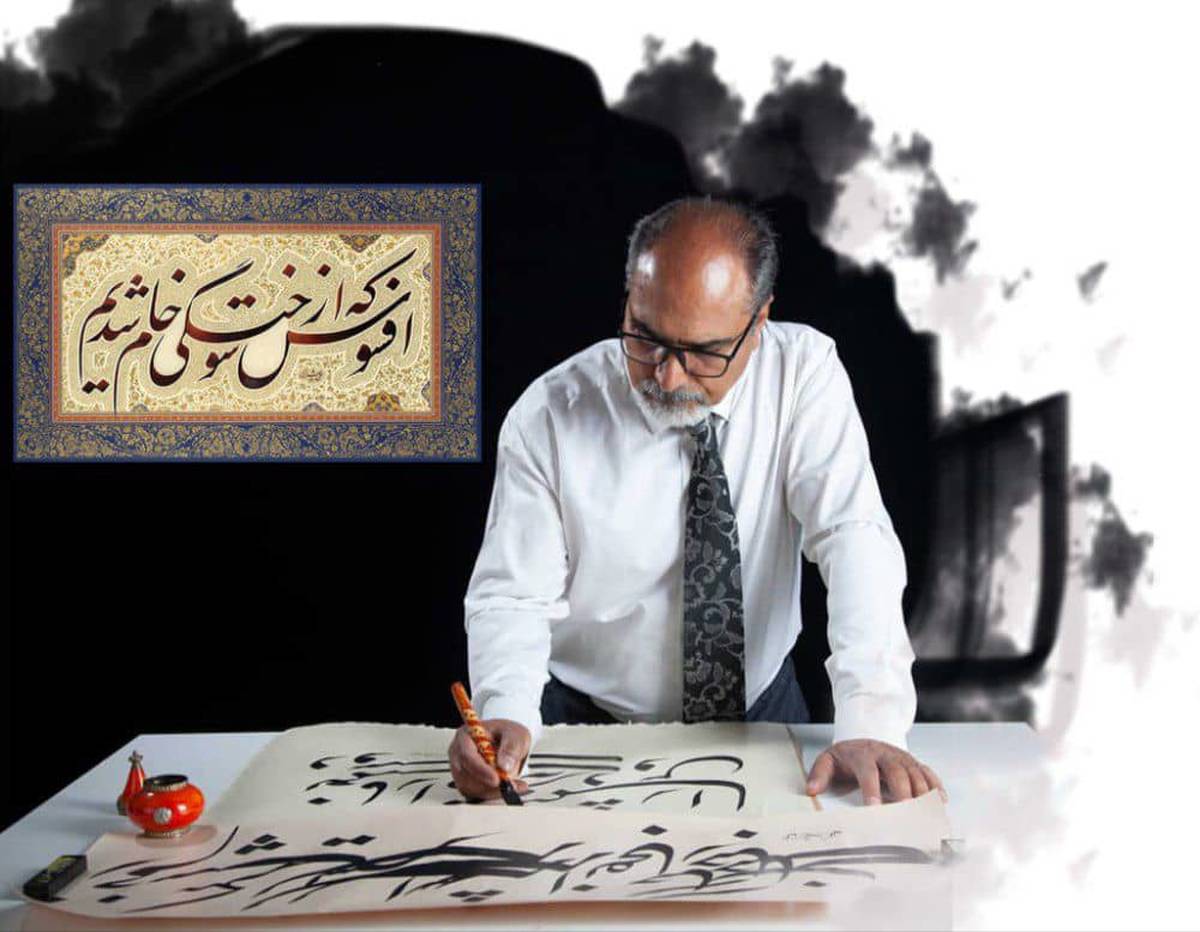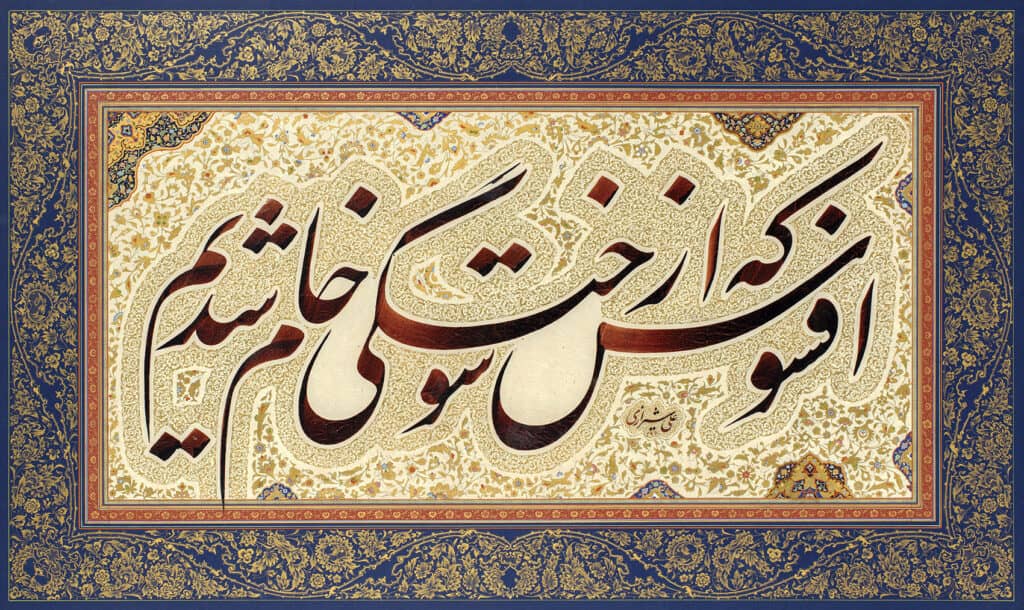
Ali Shirazi | Ali Shirazi Calligraphy
Ali Shirazi's Nastaliq Calligraphy Sets a Record | Work Analysis
Iranian calligraphy's legendary instructor, Gholam Hossein Amirkhani, recently told the media that modern Iranian Nastaliq should be separated into two categories: before and after Ali Shirazi. It is likely because of this process that a classic Nastaliq by Shirazi, which auctioned for $10,353 at the 22nd edition of the Tehran Auction, became one of the most expensive pieces of classical calligraphy ever sold in the contemporary era.
ArtDayMe : The calligraphy piece “Unfortunately, We Were Left Raw from the Burn” by Ali Shirazi, which was made in 2017 using the ink and acrylic technique on handmade paper, is analyzed and examined in this article. It measures 87 by 51 centimeters and set an amazing record on February 15, 2025, at the 22nd Tehran Auction held at the Parsian Azadi Hotel.
Experts at Tehran Auction valued the calligraphy at between 4,000,000,000 and 6,000,000,000 IRR, but the piece sold for an astounding $10,353 after an amazing increase of more than double the original price.

1:
Ali Shirazi's calligraphy is a superb illustration of how Iranian calligraphy combines classic artistry with contemporary creativity. This work demonstrates a high degree of craftsmanship and aesthetics with its distinct Nastaliq, creative color contrast, beautiful illuminated manuscript ornamentation, and dynamic composition. The piece exudes a profound sense of mystical and emotional depth and is remarkable both conceptually and in terms of calligraphy.
The flowing movements, eye-catching strokes, and many combinations of letter thicknesses all demonstrate the calligrapher's ability to control the shape and balance of the letters. This fluctuation in letter width, in addition to improving readability and visual appeal, has contributed to the work's rhythmic composition. Key words have received more attention as a result of the different thicknesses.
2:
The capacity to use large pens and the ability to write continuously with the same large pens are two separate qualities that the calligraphy community acknowledges Ali Shirazi possesses. The combination of these two traits by artist, which is also evident in this work, differentiates him from other artists in this field of art, and is undoubtedly one of the reasons that drove Master Gholam Hossein Amirkhani to make that historical judgment.
3:
The arrangement of the text in the piece directs the viewer's attention to the letters' organic motion. As a result, a sort of visual music was produced.
4:
By paying attention to the negative space surrounding the letters, the work of art has become more aesthetically pleasing and balanced.

5:
Black, reddish brown, gold, and cream colors have all been used to produce harmony and an opulent look. In addition, the contrast between light and dark hues has made the calligraphy forms easier to read and more noticeable. The work's visual depth has also been enhanced by the illuminated manuscript and golden background. Furthermore, the lines shine out because to the light and textured background, which perfectly complements the work's hue.
6:
The work's beauty has been enhanced by the use of traditional illuminated manuscripts with Arabesque and Khatai designs, which have been expertly created around the text. The true style of Iranian calligraphy is reflected in the delicate and golden designs that adorn the margins. Master Peyman Golkar prepared the illuminated manuscript for the work.
7:
Iranians are familiar with the caustic, sarcastic, and interpretive statement in the work's text “Unfortunately, We Were Left Raw from the Burn”.
Despite being amusing, this literary allusion nevertheless suggests a mystical and emotional horizon. As a result, it is crucial that the words' readability, line motions, and arrangement all correlate with the text's content and improve the sense of movement and conceptual flow.
The fluidity and vitality of broken Nastaliq wonderfully complements the content of sentiments and emotions. The use of long strokes and curving movements in the line creates an emotional and mystical expression that is consistent with the essence of Persian poetry, and the master calligrapher has done an excellent job at it.
8:
Ali Shirazi's calligrams are housed in priceless collections throughout the Middle East and Asia, such as the Islamic Arts Museum Malaysia, Mohammad Al Murr collection in the UAE, Sultan Bin Ali Al Owais Cultural Foundation in Dubai, Hassan bin Mohamed Al Thani collection in Qatar, Sharjah Art Museum, National Museum of Qatar, the Anwar Gargash collection in Dubai, the Juma AI-Majid Center for Culture and Heritage in Dubai , the treasure of the Pasargad Bank Museum, Tehran's Quran Museum and Imam Ali Religious Arts Museum.

Shirazi's calligrams, like his classic calligraphies, are in high demand in the Middle Eastern art market. In addition to his recent $33,400 sale at the 19th Tehran Auction and his record-breaking $60,000 sale at Christie's in 2012, he has had exciting and successful auctions at Bonhams London and other locations; examples of these can be found on credible websites like Art Price:
https://images.app.goo.gl/KfPodCaRJG7eBnGg9

LEAVE A RELPY